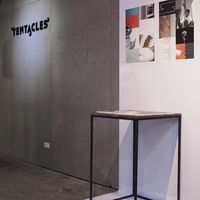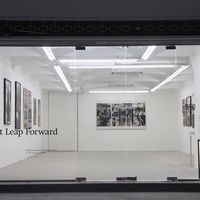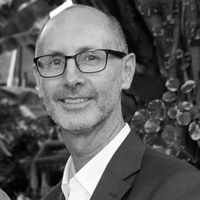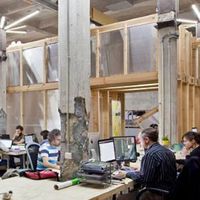HANGAR, Spain | Interview with Tere BADIA

As part of the series By People/In Cities, ASEF culture360 contributor David FERNÁNDEZ interviews Tere BADIA, Director of HANGAR, a centre for art research and production, offering support to visual artists.
David FERNÁNDEZ: What motivated you to take over Hangar direction?
Back in 2010 the call to run Hangar went out. By that time I had just recently finished a strategic plan for research, development and innovation for the visual arts commissioned by now extinct Catalonia Visual Artists Association. I had just started working on a project called Disonancias (renamed Conexiones Improbables), a platform about using arts to research and develop other non-artistic fields. When the call came out, it directly appealed to the artistic research areas I was specifically working on in the last years. I felt I had some knowledge to offer, especially after my research on cultural policies and particularly on alternative art-run spaces linked to new technologies.
DF: What did you set out to achieve when you moved to Hangar? How this idea took shape and could you make it possible?
Initially, in terms of management, the main objective was to build up a more horizontal working structure where decisions were taken by every member of the organization, while on purpose trying to contaminate those decisions with multiple perspectives and leaving behind the pyramid model. Regarding the content, the focus point was mainly on art research, I wanted to reshape the approach to artistic investigation in order to be able to recognize it as a valuable source of knowledge. In this sense, I have been trying to boost the knowledge communities, without forgetting our commitment towards the best work and production conditions for the visual artists in our centre.
DF: How have your aims/expectations changed since you started working at Hangar?
At the beginning we looked up to the established institutions of knowledge, either the academia or other scientific centres of reference, aiming to reach the approval to be recognized as a research centre by following the standardization of our research processes. By doing this, we realised the role of experimental centres like Hangar, it isn’t really to follow a discipline methodology but an undisciplined one. We prefer to look outside that rigid methodology, trying to break it if necessary. This is, in my opinion, where an art research centre like ours should be positioned, trying to question in a very rigorous manner not just the concepts but also the methodologies.
DF: How do you engage with the audience in order to present this creative hub and its experimental developments?
When you analyse the activity of Hangar you become aware of part of the processes involved in the activities we host at our centre, most of them seems to be located in a dark, hidden area of artistic knowledge. Truth be told, we do not focus our efforts on dissemination; in fact we are still working on the professionalization of our communication methodology. But we are now trying to open our production and research centre to a broader audience by inviting general public to experience the creative processes developed inside Hangar workshops. For instance, Paratext, our monthly meetings with our resident artists opened to the public, which enable interaction with the artists themselves about specific projects or part of their on-going works or Open Thursdays!, where once a week some of the resident artists and collectives open their studio and labs to offer an informal meeting with whoever desires to come and visit. Last, we are now about to launch a new web platform to host and share all our research results, so visitors can also have that information accessible via online.
DF: While developing Hangar programme, have you recently encountered any project that you felt strongly about?
Here I would like to highlight Grid Spinoza, the communication platform of Hangar’s research area, a project initiated in collaboration with the Biomedical Research Park of Barcelona. The project started in 2010 with the objective of generating a context for exploring the processes, methodologies and dynamics of artistic and scientific research paying attention to the confluences between them and the ways of transferring knowledge from one field to the other. Grid_Spinoza has three different lines of work: an online archive of texts and audiovisual documents developed by or in collaboration with artists and scientists; the Protocol for Interdisciplinary Research which aims to provide useful references and guidelines for institutions, funding bodies, individual researchers and interdisciplinary research groups; and a workshop and residency programme that consists in intensive and interdisciplinary encounters between artists and other professionals for the partial development of their research projects.
DF: What are the most important focus points of Hangar?
In brief, Hangar’s mission is to support the visual artists and creators during the different phases of their art production processes as well as to contribute to the best development of their projects. For doing so, Hangar facilitates them with equipment, facilities, production assistance and a suitable context for experimentation and free knowledge transfer.
DF: What are your plans for the future of Hangar, do you have any specific goals you would like to attain in the future?
The main focus at the moment and for the near future is the knowledge communities around Hangar project. Before my departure next year, apart from consolidating the establishment of this self-proclaimed self-determined artistic research centre, I would like to keep contributing to the recognition of artistic research as a way to produce new knowledge, to develop joint work lines between artists and researchers, to give advice on public policies for artistic R+D and to create new dissemination channels for artistic research. Besides that, and together with the board of trustees, the team, and other agents participating in the different communities involved, we are rethinking the ways of governance for the institution itself, with the aim of safeguard the inquisitiveness that Hangar represents.
DF: What would you say has been the biggest thing that the development of Hangar have taught you about the local creative arena since you took the position?
Surely I have learned a lot from my privileged position and also through the artists’ eyes about the current practices and perspectives of the contemporary cultural production throughout my last 6 years at Hangar but one thing I find very defining about the current times is the fact that nowadays the artistic practice is eminently collaborative. On a daily basis we can see here at Hangar how resident artists from varied disciplines with very different backgrounds, even though each of them have their own workshop space end up sharing their very own problematics, creating a constant dialogue about the type of work that they are developing.
DF: Have you ever participated into any European projects with other creative spaces? Have you done any collaboration also out of Europe (in Asia in particular)?
At an international level, Hangar has carried out more than 50 artists exchanges with other centres around the world. Since 2007 it participates as a partner in several European cooperation projects, most of them in the field of new technologies applied to art and creativity.
In Asia, in recent years, we have engaged in cooperation with various organizations through several international exchange programmes, including Seoul Art Space Geumcheon (Seoul, Korea), Tokyo Wonder Site (Tokyo, Japan) and Grey Projects (Singapore).
DF: What is Barcelona cultural scene like nowadays? How would you describe Barcelona and its creative community?
Despite all the difficulties generated both by the economic crisis and also by some of the cultural policies that have been implemented in the last few years, the local arts & cultural scene in Barcelona is certainly stretching up. While emerging independent collaborative artists-run spaces are constantly flourishing, also new multidisciplinary public-funded spaces, the latest Fabra i Coats, are also aiming to become a point of reference. Meanwhile other well-established cultural centres such as MACBA, La Virreina or Arts Santa Mònica are currently examining their role in a much more complex cultural landscape. Also new tools such as GRAF, a web-based calendar focused on the contemporary art scene in Catalonia are adding more visibility to the ever-evolving contemporary local creative scene.
To find out more about HANGAR, please visit: https://hangar.org
___
David FERNÁNDEZ is a Spanish-born contributing writer based in Bangkok, Thailand. Currently working as freelance arts & cultural project manager and digital media consultant, he is also one of the co-founders of Cho Why multi-disciplinary project space. He previously co-founded Le Cool Bangkok arts & culture webzine and worked as content director. Formerly, he served as cultural attaché at the Embassy of Spain – Cultural Office in Bangkok.






